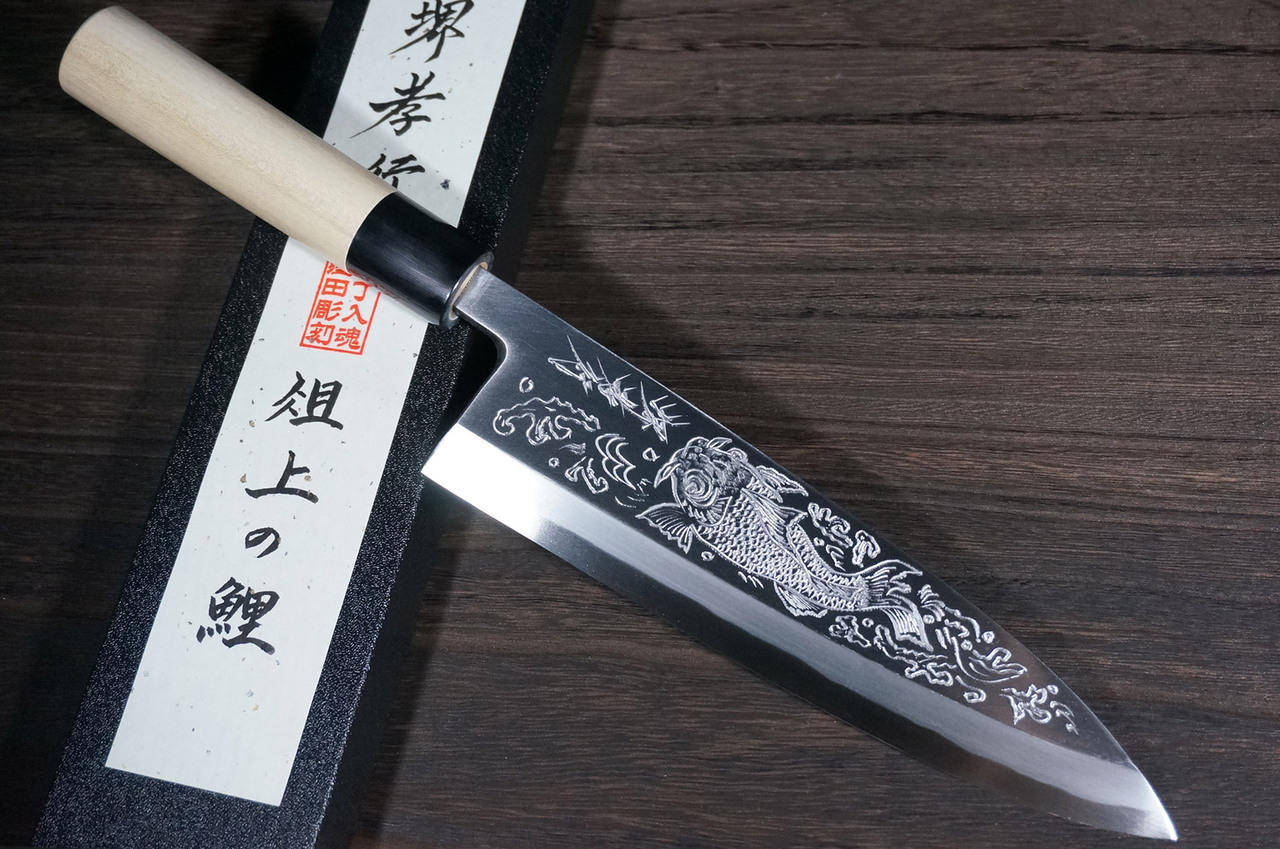In Japan, the most popular type of kitchen knife is made from white steel. These knives are prized for their sharpness and durability. White steel knives are made from a high-carbon steel that is hardened through a process called quenching.
Quenching involves heating the steel to a very high temperature and then cooling it quickly in water or oil. This process gives the steel its hardness and strength.
If you’re a fan of Japanese knives, then you’ll love Japanese white steel knives. These knives are made from a type of steel that is known for its strength and durability. It’s also said to be able to take a sharp edge and hold it longer than other types of steel.
Japanese white steel knives are perfect for anyone who wants a high-quality knife that will last them a long time. If you take care of your knife, it can easily become your go-to knife in the kitchen. Whether you’re slicing vegetables or meat, these knives can handle the task with ease.
If you’re looking for a new knife to add to your collection, then consider getting one made from Japanese white steel. You won’t be disappointed with its performance!

Credit: www.hocho-knife.com
Is Blue Or White Steel Better?
blue steel is better then white steel becouse it is harder and stronger. It can also take a sharper edge.
What is White #1 Steel?
White #1 steel is a type of carbon steel that is categorized by its high chromium content. This steel is made using a process called basic oxygen furnacing, which helps to improve its strength and hardness. White #1 steel is often used in the production of knives and other cutting tools due to its exceptional wear resistance.
What is the Difference between White And Blue Steel?
There are two types of steel: white and blue. White steel is made by adding carbon to iron, while blue steel is made by adding other metals, such as chromium or manganese, to iron. The main difference between the two types of steel is their appearance.
White steel is typically bright and shiny, while blue steel has a duller color. Blue steel is also harder than white steel and is better suited for making knives and other cutting tools.
What is White Steel No 2?
White steel No. 2 is a type of uncoated low-carbon steel that is used in various applications where corrosion resistance is required. It has a higher carbon content than other types of white steels, which gives it better corrosion resistance properties.
white steel knives review
White Steel Knife
If you’re looking for a knife that can handle anything you throw at it, look no further than the white steel knife. This knife is made from high quality materials and construction, making it one of the most durable knives on the market. It’s also incredibly versatile, able to handle any task you need it to.
Whether you’re slicing vegetables or carving a roast, this knife will get the job done quickly and easily.
So what makes this knife so special? First, the blade is made from high carbon white steel.
This gives the blade incredible strength and durability, meaning it will withstand years of use without dulling or chipping. The edge is also incredibly sharp, making it perfect for precision tasks like slicing cheese or cutting meat. And because the blade is full tang, it won’t snap off even if you put it under a lot of pressure.
The handle is also made from durable materials, ensuring a comfortable grip that won’t slip in your hand during use. It’s contoured to fit perfectly in your hand, and the bolster provides extra stability and control while you’re working. The end result is a knife that feels great in your hand and provides ultimate control while you’re using it.
If you’re looking for a top-quality knife that can handle anything you throw at it, look no further than the white steel knife.
Japanese Steel Knives
Japanese steel knives are some of the sharpest and most durable knives on the market. They’re perfect for any home cook or professional chef who wants to create amazing meals. Here’s everything you need to know about Japanese steel knives, including how to choose the right one for your kitchen.
When it comes to choosing a knife, there are many factors to consider. But if you’re looking for a high-quality, long-lasting knife, Japanese steel is the way to go. Japanese steel knives are made from a variety of steels, each with its own unique properties.
The most common types of Japanese steel used in knives are carbon steels and stainless steels.
Carbon steels contains carbon as the main alloying element. It’s harder than stainless steel, so it holds its edge longer but is more susceptible to rust and corrosion.
Stainless steel has chromium as the main alloying element and doesn’tRust or corrode as easily as carbon steel but isn’t quite as hard, so it doesn’t stay sharp for as long.
When shopping for a Japanese steel knife, look for one that’s been heat treated properly. A good heat treatment will produce a hard yet tough blade that can take and hold a very sharp edge.
Avoid knives that have been poorly heat treated because they’re more likely to chip or break when used heavily.
One of the best things aboutJapanese steel knives is that they come in a wide range of prices.
White Carbon Steel
White carbon steel is a type of low-carbon steel that has been treated with an oxide film to make it appear white in color. This makes it ideal for use in applications where a white finish is desired, such as in kitchen appliances or automotive parts. The main advantage of white carbon steel over other types of steel is its lower cost.
However, it should be noted that this material is not as durable as other types of steel and is more susceptible to corrosion.
White Steel No 1 Vs No 2
There are two types of white steel commonly used in knives, White Steel No. 1 and White Steel No. 2. Both steels are made by Hitachi and are similar in composition, but there are a few key differences that affect knife performance.
White Steel No. 1 has a slightly higher carbon content than White Steel No. 2, which gives it better edge retention and wear resistance.
However, this also makes it more difficult to sharpen and can lead to chipping if not done carefully. It is considered a good all-purpose steel for general use applications.
White Steel No. 2 has slightly less carbon than White Steel No. 1, making it easier to sharpen while still providing good edge retention and wear resistance.
It is often used in budget knives or for applications where a very sharp edge is not required (such as chopping vegetables).
So which one is better? It really depends on what you need the knife for and how much time you’re willing to spend sharpening it.
If you’re looking for an all-purpose knife that will hold up to regular use, go with White Steel No. 1.
White Steel Vs Vg10
When it comes to kitchen knives, there are a lot of different materials that can be used to make the blade. Two of the most popular options are white steel and VG10. So, what’s the difference between these two materials?
White steel is a high carbon steel that contains a small amount of chromium. This makes it extremely hard and durable, but also susceptible to rusting if not properly cared for. VG10 is also a high carbon steel, but it contains a higher percentage of chromium which makes it more resistant to rusting.
However, this also makes VG10 slightly less hard than white steel.
So, which one is better? It really depends on your needs and preferences.
If you want a knife that is extremely durable and can take a lot of abuse, then white steel is the way to go. However, if you’re worried about rusting or simply want an easier-to-care-for knife, then VG10 might be better suited for you.
Does White Steel Rust
White steel is an alloy of iron and carbon, often containing other elements such as manganese. It has a higher carbon content than regular steel, which gives it superior hardness and strength. However, this also makes it more susceptible to rusting.
White steel does indeed rust, although not as easily as regular steel. The extra carbon in the alloy forms a protective layer on the surface of the metal that slows down the corrosion process. However, if this layer is damaged or breached in any way,rust can start to form very quickly.
There are several ways to prevent white steel from rusting. First and foremost, it’s important to keep the metal clean and free of debris that could potentially damage the protective layer. If the metal will be exposed to moisture or humidity, it’s important to apply a coat of paint or sealant that will create an additional barrier against corrosion.
Conclusion
Japanese steel knives are considered some of the best in the world. They are made with a very hard type of steel that holds an edge well and is very easy to sharpen. Japanese knives also tend to be lighter than European knives, making them easier to use for extended periods of time.
